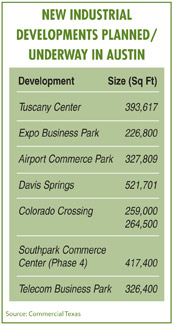| TEXAS SNAPSHOT, JUNE 2007
Austin Industrial Market
The majority of industrial development in Austin is taking place in the Southeast submarket due to an abundance of land for future development, lower land prices, fewer environmental barriers to entry and its proximity to State Highway 130, IH-35, Highway 71 and Highway 183 increases the mobility to the market from all parts of Austin, according to Lee Ellison, associate vice president with Austin-based Commercial Texas. Several large projects, such as the 226,800-square-foot Expo Business Park and the 327,809-square-foot Airport Business Park (see “New Industrial Developments Planned/Underway in Austin” chart), are planned or underway and will create an upsurge in leasing activity in this part of town. “These projects will add a significant amount of square footage that will be available in the Southeast market,” says Dan Meyer, an associate with Commercial Texas. “The Southeast market currently has one of the lowest vacancy rates in the industrial market, but by year-end there will be over 1 million square feet of new construction available.”
The Northwest submarket is seeing strong industrial activity as well, such as the Davis Springs development, which will combine office and flex space. “There is a demand for high-end flex and value office due to the increasing rental rates for traditional office space in the Northwest and Southwest markets,” Ellison says. “The Northwest market will continue seeing demand from new toll roads that increase mobility to this market.”
One of the industrial trends that has continued in Austin is the development of flexible industrial space that can be used as flex/office or traditional warehouse space, with 24-foot clear heights, 120- to 150-foot bay depths and large truck courts that can be striped for parking to accommodate a flex user. “Austin is not a big distribution market, and therefore these new developments can accommodate a wide variety of users,” Ellison says. “The developers are constructing buildings that are adaptable to either traditional flex or traditional warehouse space.”
The usual suspects, such as HPI Real Estate Services & Investments and Transwestern Commercial Services, continue to be active developers in Austin’s industrial market, as well as a few new faces that are entering the market for the first time. San Diego-based St. Croix Capital Corporation, for example, is buying several large tracts around Austin for future development and will soon break ground on the first phase of Colorado Crossing, a new industrial campus in Southeast Austin that will total approximately 500,000 square feet when completed.

High-tech suppliers, service, light manufacturing and distribution companies are the types of tenants these new industrial properties in the Austin area are trying to attract. High-tech companies have traditionally chosen Austin as a preferred place to do business; therefore, high-tech suppliers and manufacturers have followed closely.

In the coming months, the Southeast submarket will continue to be the area to watch in Austin in terms on industrial activity, according to Meyer and Ellison. “A large amount of space, 1 million square feet plus, is coming on line over the next year,” Meyer says. “It will be interesting to see how well and how quickly it is absorbed.”
— Lee Ellison is associate vice president and Dan Meyer is an associate with Austin-based Commercial Texas.
©2007 France Publications, Inc. Duplication
or reproduction of this article not permitted without authorization
from France Publications, Inc. For information on reprints of
this article contact Barbara
Sherer at (630) 554-6054.
|
